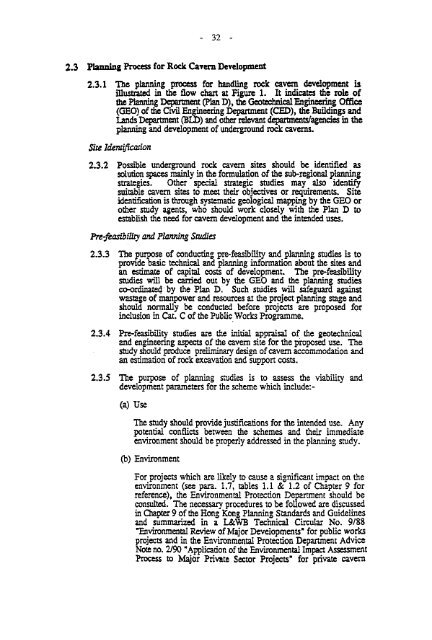miscellaneous planning standards and guidelines - HKU Libraries
miscellaneous planning standards and guidelines - HKU Libraries
miscellaneous planning standards and guidelines - HKU Libraries
Create successful ePaper yourself
Turn your PDF publications into a flip-book with our unique Google optimized e-Paper software.
322.3 Planning Process for Rock Cavern Development2.3.1 The <strong>planning</strong> process for h<strong>and</strong>ling rock cavern development isillustrated in the flow chart at Figure 1. It indicates the role ofthe Planning Department (Plan D), the Geotechnical Engineering Office(GEO) of the Civil Engineering Department (CED), the Buildings <strong>and</strong>L<strong>and</strong>s Department (BID) <strong>and</strong> other relevant departments/agencies in the<strong>planning</strong> <strong>and</strong> development of underground rock caverns.Site Identification23.2 Possible underground rock cavern sites should be identified assolution spaces mainly in the formulation of the sub-regional <strong>planning</strong>strategies. Other special strategic studies may also identifysuitable cavern sites to meet their objectives or requirements. Siteidentification is through systematic geological mapping by the GEO orother study agents, who should work closely with the Plan D toestablish the need for cavern development <strong>and</strong> the intended uses,Pre-feasibiUty <strong>and</strong> Planning Studies2.3.3 The purpose of conducting pre-feasibility <strong>and</strong> <strong>planning</strong> studies is toprovide basic technical <strong>and</strong> <strong>planning</strong> information about the sites <strong>and</strong>an estimate of capital costs of development. The pre-feasibilitystudies will be carried out by the GEO <strong>and</strong> the <strong>planning</strong> studiesco-ordinated by the Plan D. Such studies will safeguard againstwastage of manpower <strong>and</strong> resources at the project <strong>planning</strong> stage <strong>and</strong>should normally be conducted before projects axe proposal forinclusion in Cat. C of the Public Works Programme.2.3.4 Pre-feasibility studies are the initial appraisal of the geotechnical<strong>and</strong> engineering aspects of the cavern site for the proposal use. Thestudy should produce preliminary design of cavern accommodation <strong>and</strong>an estimation of rock excavation <strong>and</strong> support costs,2.3.5 The purpose of <strong>planning</strong> studies is to assess the viability <strong>and</strong>development parameters for the scheme which include: -(a) UseThe study should provide justifications for the intended use. Anypotential conflicts between the schemes <strong>and</strong> their immediateenvironment should be properly addressed in the <strong>planning</strong> study.(b) EnvironmentFor projects which are likely to cause a significant impact on theenvironment (see para. 1.7, tables 1.1 & 1.2 of Chapter 9 forreference), the Environmental Protection Department should beconsulted. The necessary procedures to be followed are discussedin Chapter 9 of the Hong Kong Planning St<strong>and</strong>ards <strong>and</strong> Guidelines<strong>and</strong> summarized in a L&WB Technical Circular No. 9/88"Environmental Review of Major Developments 11 for public worksprojects <strong>and</strong> in the Environmental Protection Department AdviceNote no. 2/90 H Application of the Environmental Impact AssessmentProcess to Major Private Sector Projects" for private cavern
















